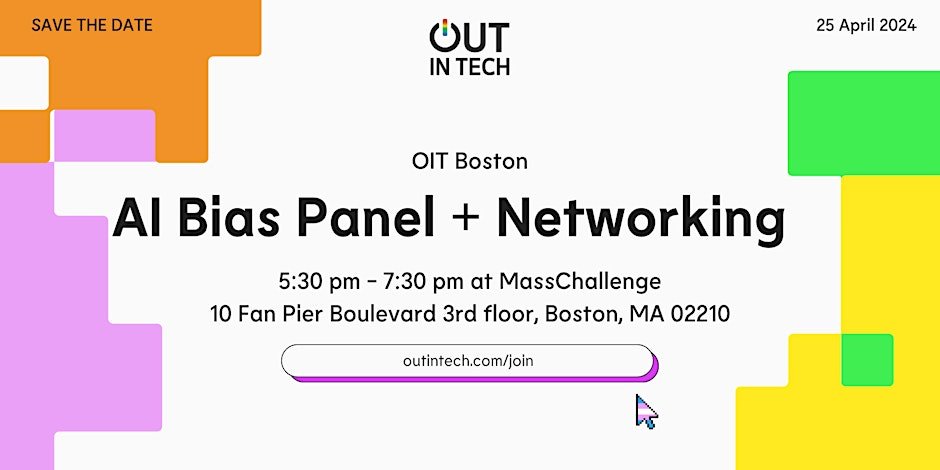
Blog Posts
AI Ethics and Bias Panel
I’m excited to be joining a panel discussion this week hosted by MassChallenge and Out in Tech. The discussion will focus on AI ethics and algorithmic bias, and I’ll be able to bring my experiences in digital transformation and AI implementation.
Join Out in Tech Boston at MassChallenge for an inclusive networking night with LGBTQ+ individuals in the tech and innovation fields across Boston. Enjoy complimentary drinks, refreshments, and networking opportunities, where you might meet your next friend or discover a new job opportunity.
The event will feature LGBTQ+ speakers discussing topics such as AI ethics and algorithm bias, educating us about intersectionality and inclusivity in navigating algorithms and digital spaces around us.
Don't miss this opportunity to connect, learn, and contribute to a more inclusive tech community!
Register for the event.
Ethics and Bias in AI Systems
Reading Kate Crawford’s “Atlas of AI”
The growth of awareness and the use of artificial intelligence (AI) in many sectors has also prompted a wide-ranging discussion about its ethical implications, both in their formation and use. Kate Crawford’s book, “Atlas of AI,” not only provides comprehensive insights into the complexities of AI systems, including the resources they consume, the labor behind them, the data that powers them, and the perspectives and biases that structure them but also empowers you with the knowledge to navigate these complexities.
Crawford’s research builds awareness of the inherent ethics and bias in current AI systems, highlighting the challenges and responsibilities facing developers and business leaders.
Power and Inequality in AI
Crawford’s examination of AI through political, economic, and environmental lenses reveals that AI is not merely a technical phenomenon but a manifestation of power. AI technologies often reflect and amplify existing social hierarchies and inequalities, making the ethical deployment of AI not just a technical issue but a socio-political challenge as well.
Reflect on the Power Dynamics:
Recognize that decisions about which technologies are developed and how they are employed can reinforce existing power structures. This requires a commitment to not only understanding but actively countering these dynamics.
Equitable AI Development:
Ensure that AI development processes involve stakeholders from varied backgrounds to prevent perpetuating existing inequalities. This includes hiring practices, team compositions, and partnership decisions.
The Materiality of AI
“Atlas of AI” also delves into AI’s material aspects, such as the environmental impact of data centers and the ethical concerns surrounding the mining of physical resources needed for hardware. This materiality underscores the environmental and human costs of AI technologies.
Sustainable Practices:
Implement environmentally sustainable practices in all stages of AI development, from data center operations to the end-of-life disposal of AI technologies.
Transparency in Resource Usage:
AI systems' energy consumption and resource requirements should be transparent to allow informed decisions.
Labor in AI
The labor required to produce and maintain AI systems is often invisible but is a critical component of ethical AI deployment. This includes not only the data scientists and developers but also the usually underpaid or unpaid workers who label training data, often in precarious conditions.
Fair labor practices should be enforced and adhered to for all workers involved in the AI lifecycle. This includes fair compensation, safe working conditions, and recognition of the contributions of data annotators and other often overlooked roles.
Labor needs to be Highlighted in AI Narratives. Educate stakeholders about the labor that supports AI technologies, challenging the myth of AI as an autonomous technology and acknowledging the human workforce that makes AI possible.
Data Ethics Beyond Bias
While data bias is a significant concern, Crawford’s analysis encourages a broader view of data ethics. This includes considerations of how data is collected, used, and stored, emphasizing respect for user privacy and autonomy.
Strategic Initiatives:
Consent and Data Governance: Develop robust mechanisms for user consent and data governance that respect user autonomy and privacy. This involves transparent data practices and substantial user control over their data.
Data Provenance: Implement systems to track the provenance of data, ensuring its ethical sourcing and maintaining records of its origins and transformations.
Expanding on the initial discussions of bias and ethics in AI with insights from Kate Crawford’s “Atlas of AI,” it becomes clear that addressing these issues requires a holistic approach. Developers and business leaders must consider not just the technical aspects of AI but also the broader implications of their work, including the environmental, labor, and socio-political dimensions. By adopting comprehensive, informed strategies for ethical AI deployment, they can lead the way toward a more equitable and sustainable future with AI.
Design in Driving Digital Transformation and Value Creation
Design in Driving Digital Transformation and Value Creation
In today’s fast-paced digital world, businesses are constantly striving to keep up with the ever-changing landscape while simultaneously driving value creation. It’s a challenging task, but one that is essential for success in the modern era. Brian Eastwood’s insights on the “4 levers that create digital value” provide a compelling framework for understanding how businesses can leverage organizational change to enhance their competitive edge. However, an often-overlooked aspect of this transformation journey is the pivotal role of design. As a design leader and business strategist, I believe integrating strong design practices is crucial for navigating these changes effectively and realizing their full potential.
Enhancing Customer Experience through Design
The customer lever focuses on identifying unique customer types and delivering tailored journeys. From a design perspective, this lever benefits immensely from employing design thinking to empathize with and understand various customer personas. Design practices encourage iterative learning through user feedback, which aligns perfectly with developing a nuanced understanding of customer journeys. By integrating design workshops and prototyping, businesses can uncover innovative customer engagement strategies and personalize experiences effectively.
Eastwood highlights the importance of identifying and delivering tailored customer journeys. Design thinking plays an essential role here by centering the customer in the development process. Empathy allows us to deeply understand customer needs and behaviors, leading to insights that drive innovative solutions. Design practices help visualize complex customer journeys and interactions, making them easier to understand and iterate upon. This not only aligns with the goal of focusing on specific customer types but also enhances sustainable growth through improved engagement and acquisition.
Streamlining Capabilities with Design Systems
When discussing capability, the article highlights the importance of creating shared business capabilities to enhance speed and efficiency. Design methodologies play a pivotal role here by fostering an environment where cross-functional teams collaborate to standardize and automate processes. Through techniques like service design, organizations can visualize entire service ecosystems, allowing for more precise identification of standard capabilities that can be streamlined or shared, reducing redundancy and enhancing efficiency.
Design methodologies can significantly benefit the discussion on creating shared business capabilities to gain speed and efficiency. Implementing design systems offers a structured approach to standardizing and automating interfaces and user experiences across different customer touchpoints. This not only ensures consistency and enhances user experience but also speeds up the process of rolling out new features. Moreover, a well-established design system enables organizations to swiftly adjust to alterations in the market or changes in customer preferences, supporting the agility required in today’s digital economy.
Design’s Role in Commercialization
The commercialization lever—turning internal capabilities into new revenue streams—resonates deeply with the principles of design-led innovation. The design process is inherently explorative, making it ideal for identifying and developing new uses for existing capabilities. By adopting a design-driven approach, companies can more effectively prototype and test these new offerings in real-world scenarios, ensuring they meet market needs before full-scale deployment.
If you’re thinking of commercializing an internal capability, take a cue from Eastwood and dive deep into understanding your target market and what your customers really need. This will go a long way in making your venture a success!. Design contributes significantly here by providing tools and frameworks to prototype, test, and validate new ideas quickly and efficiently. This iterative process helps minimize risks associated with new ventures and maximizes the potential for success. Additionally, design can help communicate the value of new services or products in a way that resonates with customers, thereby enhancing the commercialization process.
Component Design for Scalability and Reuse
The component lever’s focus on driving consistency and speeding up the market launch of digital models is where design’s role in systematizing and standardizing elements can truly shine. In design, particularly within the realm of digital products, modular design frameworks are utilized to ensure components can be easily reused and adapted across different parts of the organization. This approach not only accelerates development but also maintains a high level of consistency and usability, which are critical for user acceptance and satisfaction.
The goal to “drive consistency and speed to market with embedded digital models” can be excellently supported by design. Modular design principles can be applied to create components that are reusable and easily integrated across different systems and platforms. This not only reduces the time and cost of development but also ensures that high standards of user experience are maintained. Effective design governance can aid in the management of these components, ensuring they are updated and optimized continuously for maximum impact.
Leadership and Governance in Design
Finally, governance and leadership in design are as critical as in any other business area. Establishing clear design leadership roles, such as a Chief Design Officer, can help in aligning various design efforts with organizational strategic goals. This role can also facilitate communication among different teams and stakeholders, ensuring that design maintains its customer focus and drives innovation.
The article rightly asserts that navigating these levers requires iterative efforts and strong governance. Design thinking adds a layer of adaptability to this governance by encouraging a culture of experimentation and iteration, where rapid prototyping and continuous feedback are embedded into the change management process. This approach helps in quickly identifying what works and what doesn’t, allowing for agile responses to market changes or internal feedback.
Moreover, design leadership can advocate for a holistic view of the organization’s strategy by aligning these four levers with a central vision focused on user experience and innovation. This alignment ensures that every department, from IT to customer service, from marketing to product development, is working towards a unified goal that enhances overall business value and customer satisfaction.
❡
Eastwood rightly points out that metrics are crucial. In design, this translates to measuring user satisfaction, engagement, and usability. These metrics not only inform design decisions but also help demonstrate the ROI of design initiatives, thus ensuring continuous support from senior management.
Eastwood’s article provides a valuable framework for organizations seeking to maximize their digital value through strategic reorganization. Integrating strong design practices into each of the four levers discussed can significantly amplify their effectiveness. As leaders, it’s our responsibility to champion these design principles, ensuring they permeate every layer of our strategic initiatives, from conception through to execution. By doing so, we not only enhance our ability to deliver outstanding value but also foster a resilient organization capable of thriving in the ever-evolving digital landscape.
While the levers identified by the MIT CISR research provide a robust framework for digital transformation, incorporating strong design practices can magnify their effectiveness. Organizations that recognize and integrate design at the core of their strategy are better positioned to navigate the complexities of digital transformation and help them emerge as leaders in the digital age. This strategic integration not only enhances user experience but also drives innovation and creates sustainable competitive advantages.
❡
If implementing these strategic methods in your organization seems daunting, or if you’re unsure how to integrate design practices effectively with your existing processes, I’m here to help. At Nick & Scratch, I specialize in marrying design thinking with business strategy to unlock maximum value and efficiency. View my services or schedule a call with us for a personalized consultation, where we can explore tailored solutions to ensure your reorganization efforts are as successful and seamless as possible. Let’s transform your challenges into opportunities together.

